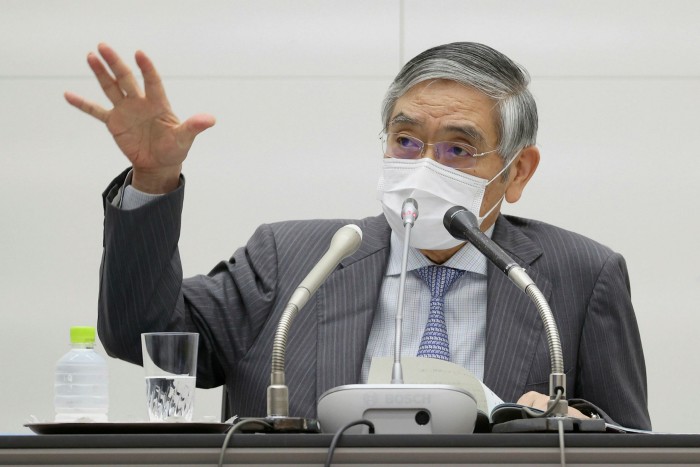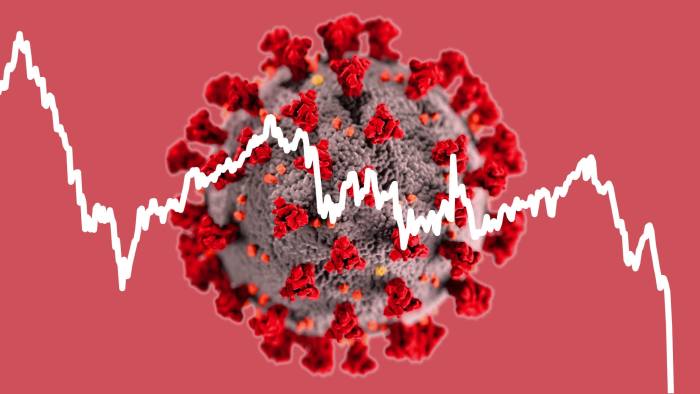The Bank of Japan will this week unveil the results of its biggest policy review since 2016 as the central bank grapples with the consequences of a monetary stimulus that has gone on for longer than anybody imagined.
Officials at the BoJ insist the review is not intended to ease or tighten monetary policy — a decision made by its policy board eight times a year — with governor Haruhiko Kuroda promising in advance that it will continue to peg 10-year bond yields at “around zero”.
Instead, the goal is to make the central bank more “nimble”. Like a boxer who missed an early knockout, the BoJ finds itself in a drawn-out struggle to reach 2 per cent inflation. The purpose of the review is to take a breather, regain a sense of control and devise a plan for final victory.
When it reveals the results on Friday, the BoJ intends to maintain the overall stimulus launched by Kuroda in 2013, under which its balance sheet has swollen to 135 per cent of gross domestic product, and the central bank has come to own about 7 per cent of the Japanese equity market.
But the review could pave the way for more variation in BoJ buying, purchasing less bonds and equities when markets are tranquil, while intervening aggressively during times of turmoil. That would allow more space for prices to fluctuate in order to address criticism that heavy-handed intervention had crushed market function.
“Although significant fluctuations in interest rates could lead to undesirable consequences, fluctuations within a certain range could have positive effects on the functioning of JGB markets without losing the effects of monetary easing,” Masayoshi Amamiya, the deputy governor often regarded as the BoJ’s policy mastermind, said in a speech last week.

On top of an economic analysis, examining why it has been so hard to raise inflation in Japan, the review is expected to look at three main policy points: the cap on 10-year bond yields at “around zero”; the prospect of deeper negative interest rates below the current -0.1 per cent; and the BoJ’s buying of equity exchange traded funds.
Initially, the BoJ encouraged speculation that it would widen the band in which 10-year bonds are allowed to trade, letting yields rise to 30 basis points above zero. However, in the past 10 days the central bank has crushed that expectation, as Japan struggles to get its Covid-19 vaccination programme off the ground and US markets go through a period of volatility.
“My sense is that Amamiya and the BoJ planning staff are still in favour of widening the band,” said Takeshi Yamaguchi, chief economist at Morgan Stanley in Tokyo.
“But there’s no strong economic reason to do it. I think it would be policy tightening and I don’t think governor Kuroda and the dovish board members will agree.”
Instead, the BoJ will probably provide less detailed schedules for its bond purchases, and it could revisit a widening of the band this year.
Another objective will be to persuade markets that the BoJ could still cut interest rates deeper into negative territory, giving it the ammunition to act in a downturn. In reality, however, the hurdle to doing so is high because it fears a backlash from the public, politicians and the financial sector.
Equity purchases may produce the biggest policy shift, reflecting the oddity of large-scale BoJ buying when the Tokyo market is at 30-year highs.
At present, the central bank pledges to buy an average of ¥6tn ($55bn) a year in equities, with an upper limit of ¥12tn ($110bn). The BoJ may drop the ¥6tn number — a significant move because having only an upper limit is compatible with buying no equities at all.
Coronavirus business update

How is coronavirus taking its toll on markets, business, and our everyday lives and workplaces? Stay briefed with our coronavirus newsletter.
“The BoJ will be more flexible: they’ll buy less exchange traded funds when prices are high,” said Yamaguchi. He added that he would prefer the BoJ to remove the ¥12tn upper limit because scrapping the ¥6tn average “gives too much discretion to the BoJ operations department”.
There is still the possibility that the BoJ will find a rabbit in its hat. Kuroda is well-known for liking to surprise markets with easing measures. Eight years after the BoJ switched to large-scale stimulus, however, there are few monetary policy options left to explore.
Masamichi Adachi, chief economist at UBS in Tokyo, said the BoJ was in danger of getting bogged down in the details of policy. “I don’t think any ordinary person not in the JGB market understands what a widening of the yield range means,” he said. “It’s all too technical.”
Read More:Bank of Japan wrestles with never-ending stimulus
2021-03-16 01:09:06
